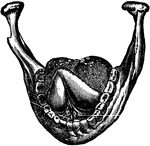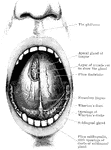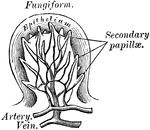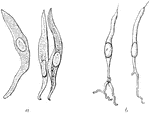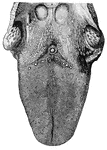Clipart tagged: ‘tongue’

Mouth and Tongue of a Bee
"The structure of the mouth in insects exhibits very remarkable modifications, and these are of the…

Brank
"Brank, or Branks, an instrument and formerly used in Scotland, and to some extent also in England,…

Fifth Cranial Nerve
The fifth cranial nerve. Labels: 1, orbit; 2, antrum of Highmore; 3, tongue; 4, lower jaw; 5, Casserian…
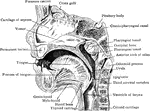
Mesial Sagittal Section of Child's Face
Anterior portion of mesial sagittal section of child's head, probably of about three year.

Bustard Gular Pouch
"Gular pouch of bustard; a, tongue; b, the pouch, opening under a, hanging in front of c, the trachea,…
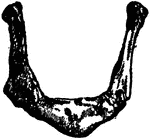
Human Hyoid Bone
The hyoid, os hyoides, or tongue bone, is an isolated, U-shaped bone lying in front of the throat, just…
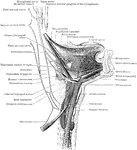
Muscles of the Hyoid Bone
The muscles of the hyoid bone and styloid process, and the extrinsic muscles of the tongue, with their…
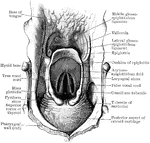
Superior Aperture of Larynx
Superior aperture of larynx, exposed by laying open the pharynx from behind.
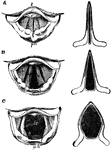
The Larynx in Different Conditions of the Glottis
The larynx as seen by means of the laryngoscope in different conditions of the glottis. Labels: A, while…

Mouth
"The mouth, nose and pharynx, with the commencement of the gullet and larynx, as exposed by a section,…
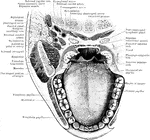
Horizontal Section Through Mouth and Pharynx
Horizontal section through mouth and pharynx at the level of the tonsils.

Mouth Showing Palate and Tonsils
Open mouth showing palate and tonsils. It also shows the two palatine arches, and the pharyngeal isthmus…

The Mouth, Nose, and Pharynx
The mouth, nose, and pharynx, with the commencement of gullet (esophagus) and larynx, as exposed by…
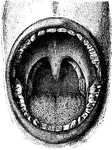
The Mouth
Interior of the mouth. Labels: 1, soft palate; 2, its median ridge; 3, uvula; 4, anterior, 5, posterior…

Mucous Gland from Tongue
Section of a mucous gland from the tongue. Labels: A, opening of the duct on the free surface; C, basement…
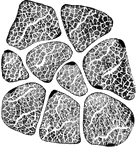
Muscular Fibers of the Human Tongue
Transverse section through muscular fibers of human tongue. The muscle corpuscles are indicated by their…
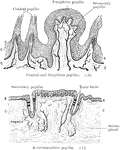
Papillae of the Tongue
The upper illustrations show conical and fungiform papillae, the lower a circumvallate papilla. Labels:…

Filiform Papillae
The epithelium covering the filiform papillae is extremely dense and thick, and projects from their…

Fungiform Papillae
The fungiform papillae are scattered chiefly over the sides and tip, and sparingly over the middle of…
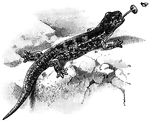
Red Salamander Eating an Insect
Spelerpes ruber. "...of a bright red color, more or less spotted with black, and is found in cold springs…
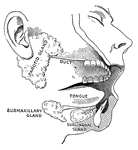
Salivary glands
"While the food is being chewed it is moistened by saliva, or spittle, which flows into the mouth from…
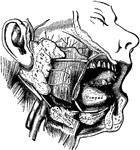
Salivary Glands
The salivary glands. One side of the lower jaw has been removed, and the face dissected, in order to…
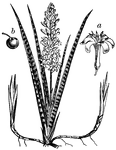
Snake Plant
Sansevieria Zeylanica is the Latin name, but this plant is also called a Mother-in-law's Tongue. "A…
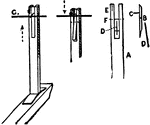
Interior mechanism of a spinet
"Interior mechanism of a spinet. A, Jack; B, tongue; C, quill; D, bristle; E, cloth damper; F, pivot;…

Taste bud of Rabbit
A, Three-quarter surface view of taste bud from the papilla foliata of a rabbit. B, Vertical section…
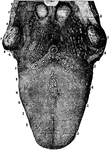
Tongue
The upper surface of the tongue. Labels: 1,2, circumvallate papillae; 3, fungiform papillae; 4, filiform…
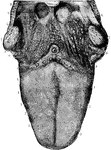
Tongue
The papillar surface of the tongue, with the fauces and tonsils. Labels: 1, circumvallate papillae,…
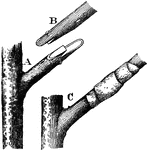
Tongue Grafting
To graft two plants together using the tongue or whip grafting approach, you must first make a sloping…

Tongue of Human and Rabbit
A, Section through papilla vallata of a human tongue. B, Section through part of the papilla foliata…
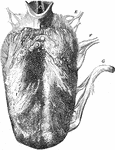
The Tongue Showing Three Kinds of Papillae
The tongue showing three kinds of papillae- the conical (D), the whiplike (K, I), the circumvallate…

Back View of the Tongue
View of the back of the tongue, from which, by maceration, the periglottis has been removed and turned…

Sections of the Tongue
A, Transverse vertical section through the tongue. B, Longitudinal vertical section through the tongue.…
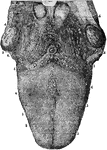
Upper Surface of Tongue
The upper surface of the tongue. Labels: 1, 2, circumvallate papillae; 3, fungiform papillae; 4, filiform…
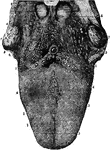
Upper Surface of the Tongue
The upper surface of the tongue with part of the pillars of the fauces and the tonsils. Labels: 1, 2,…
Combined Tongue and Thill for Vehicles
One of the two long pieces of wood, which extends before a vehicle cart and attaches to a horse hitched…

Vocal Apparatus
Image of vocal apparatus as seen in the laryngoscopic mirror held far back in the mouth.
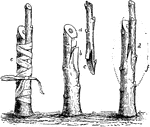
Whip-Grafting
"Whip-grafting or tongue-grafting is the most usual mode of performing the operation. The stock is headed…

Woodpecker Tongue
This illustration shows the special development of tongues of woodpeckers; a, skull of flicker, showing…
Woodpecker Tongue
An illustration of a woodpecker's tongue. The long sticky tongues, which possess bristles, aid these…

